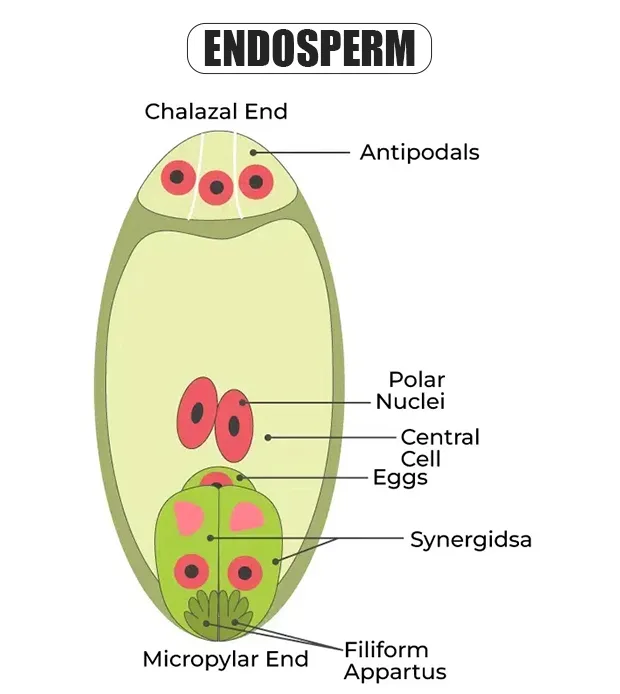
Endosperm: Endosperm is a vital tissue found in flowering plant seeds that surrounds and nourishes the embryo. It is a transient but essential component, accounting for the majority of the grain. Endosperm, which is high in carbohydrates, proteins, and lipids, supplies the developing embryo with essential nutrition in the form of starch, oils, and protein. It also acts as a protective barrier, regulating embryo growth throughout seed development and germination. Endosperm is essential for human nutrition because it provides roughly two-thirds of all human calories. The article below provides students in Class 12 with detailed information about endosperm.
Sexual Reproduction in Flowering Plants
What is Endosperm Class 12?
Endosperm is an essential component found in the seeds of most angiosperms or flowering plants. This tissue grows inside the seeds through a process known as Double fertilisation. Most plant species are triploid, which means that they have three sets of chromosomes per nucleus. Angiosperms are plants that have flowers and produce seeds inside a fruit. Angiosperms refers to various plants that produce fruits, grains, vegetables, and flowers. An angiosperm's seed is made up of three parts: the seed coat, the endosperm, and the embryo. The endosperm surrounds the embryo and provides nutrition, primarily in the form of starch, but it may also contain oils and proteins. The endosperm surrounds the embryo and provides nutrition, primarily in the form of starch, but it can also contain oils and proteins. This article provides a detailed overview of endosperm, including its functions, diagram, structure, types, and the Double fertilisation process.Endosperm Diagram
The endosperm diagram is as follows:
Types of Endosperm
Endosperms are classified into three types according to their developmental patterns. The formation of endosperms, also known as "Double fertilisation,".Each pollen grain contains two male gametes, one of which fuses with the ovary to form a zygote and the other produces triploid endosperm. This endosperm develops further, protecting the seed from internal and external threats by sensing and responding to its surroundings in preparation for fertilization.- Nuclear Endosperm: This type is prevalent among plants. In nuclear endosperm, the Primary Endosperm Nucleus (PEN) undergoes multiple mitotic divisions without cytokinesis. This results in numerous free nuclei within the cell, arranged peripherally around a large central vacuole. The chalazal and micropylar ends contain more nuclei compared to the sides. Cell wall formation commences from the periphery towards the centre, culminating in multicellular endosperm.
- Cellular Endosperm: This type is less common. Cellular endosperm development involves PEN division (karyokinesis) followed by cytokinesis, resulting in transverse division and the formation of two cells. These cells give rise to the chalazal and micropylar chambers, followed by further divisions leading to cellular endosperm formation.
- Helobial endosperm: This type is predominant in monocotyledons. It begins with a division akin to cellular endosperm, resulting in a large micropylar cell and a small chalazal cell. Subsequent divisions in the micropylar cells resemble nuclear endosperm. Helobial endosperm thus represents an intermediate type, combining characteristics of both nuclear and cellular endosperms.
Double Fertilisation
Double fertilisation is a complex and distinct reproductive mechanism found in flowering plants (angiosperms), in which two sperm cells from a pollen grain combine with two different female structures within the ovule. fertilization is a complex and distinctive reproductive mechanism in flowering plants (angiosperms) wherein two sperm cells from a pollen grain unite with two different female structures within the ovule. This process leads to the creation of both the embryo and the endosperm, which is the tissue responsible for storing nutrients to support the growing embryo. The Double fertilisation process can be broken down into the following steps:- Pollination: A pollen grain lands on the stigma, the receptive part of the carpel (the female reproductive organ) in a flower.
- Pollen tube formation: The pollen grain germinates, forming a pollen tube that grows down through the style (the structure connecting the stigma to the ovary) towards the ovule.
- Double fertilisation: The pollen tube enters the ovule through a small opening known as the micropyle. Inside the ovule, the pollen tube releases two sperm cells.
- One sperm cell fertilizes the egg cell, forming a zygote with a full set of chromosomes. This zygote develops into the embryo of the seed.
- The other sperm cell combines with the two polar nuclei (central cell) in the ovule, producing a triploid primary endosperm nucleus (PEN). This PEN develops into the endosperm, which provides nutrients for the developing embryo.
Importance of Double fertilisation includes:
- Being an important stage in the sexual reproduction of flowering plants.
- Ensure the growth of both the embryo (which gives rise to the new plant) and the endosperm (which feeds the developing embryo). developing embryo).
- The triploid nature of the endosperm may enhance its ability to store nutrients.
| Other NEET Biology Topics | ||
|---|---|---|
| Ribosomes | Pollination | Apomixis |
| Centrosome | Embryo | Tissues |
| Rhizopus | Pinus | Gluconeogenesis |
| Chlamydomonas | Chara | Ribs |
Development of Endosperm
The growth of the endosperm in flowering plants is a crucial process that ensures the proper nourishment of the developing embryo. This growth takes place inside the seed and is vital for the successful germination and growth of the plant. The development of the endosperm can be divided into several distinct stages:- Double Fertilisation: Endosperm development begins with the process of double fertilisation, which is a unique feature of flowering plants. In this process, one sperm nucleus fertilises the egg cell to form the embryo, while the other sperm nucleus fertilises the central cell, leading to the formation of the endosperm.
- Syncytial Stage: After fertilisation, the endosperm goes through a phase of rapid nuclear divisions without cytokinesis, resulting in a multinucleate structure called a syncytium. This stage is crucial for the rapid accumulation of nutrients in the endosperm.
- Cellularisation: Subsequently, the syncytial endosperm undergoes cellularisation, during which cell walls form around individual nuclei, leading to the formation of distinct cells within the endosperm. This cellularisation process is essential for the proper development and function of the endosperm.
- Nutrient Accumulation: Throughout its development, the endosperm accumulates various nutrients, including starch, proteins, and lipids. These nutrients serve as a source of energy and building blocks for the developing embryo and seedling.
- Regulation by Genes and Hormones: The development of the endosperm is tightly regulated by a complex interplay of genetic and hormonal factors. Genes encoding storage proteins and other compounds are expressed at specific stages to facilitate nutrient accumulation. Hormones such as auxins, cytokinins, and gibberellins also play critical roles in coordinating endosperm development.
- Variation among Species: The structure and composition of the endosperm can vary among plant species. For example, some plants have endosperm that is rich in starch, while others have endosperm that is rich in proteins or oils. These variations can influence the nutritional content and other characteristics of the seed.
- Significance for Agriculture: Understanding the development of the endosperm is important for agriculture, as it can influence crop yield and quality. Manipulating endosperm development through breeding or genetic engineering can lead to the development of crops with improved nutritional content, yield, and resilience to environmental stresses.
Endosperm Functions
The following are the features of endosperm:- Endospermic Seeds: In some dicots like castor, mature seeds store food in the endosperm.
- Exalbuminous Seeds: In beans, peas, and gram seeds, the endosperm is completely absorbed during development, and food is stored in two cotyledons.
Endosperm Examples
Examples of Endosperm in Plants:- Castor Seeds: Endospermic seeds store food for seedling growth.
- Beans, Peas, Gram Seeds: Exalbuminous seeds absorb endosperm during development.
- Grains (Wheat, Maize, Barley, Corn): Endosperm is the main food source for seedlings.
- Coconut: Coconut seeds contain liquid endosperm.
- Wheat Seeds (White Flour): White flour is made from the endosperm of wheat seeds.
- Orchids: Orchid seeds do not have endosperm.
| NEET Exam Important Links | |
|---|---|
| NEET Biology Syllabus | NEET Biology Diagrams |
| NEET Biology MCQ | NEET Biology Chapter wise Weightage |
| NEET Biology Notes | NEET Previous Year Question papers |
Endosperm FAQs
What is the role of endosperm in plants?
What are the three types of endosperm?
Which plants have endosperm?
Is endosperm a male or female part of the plant?
What is the structure of endosperm?










